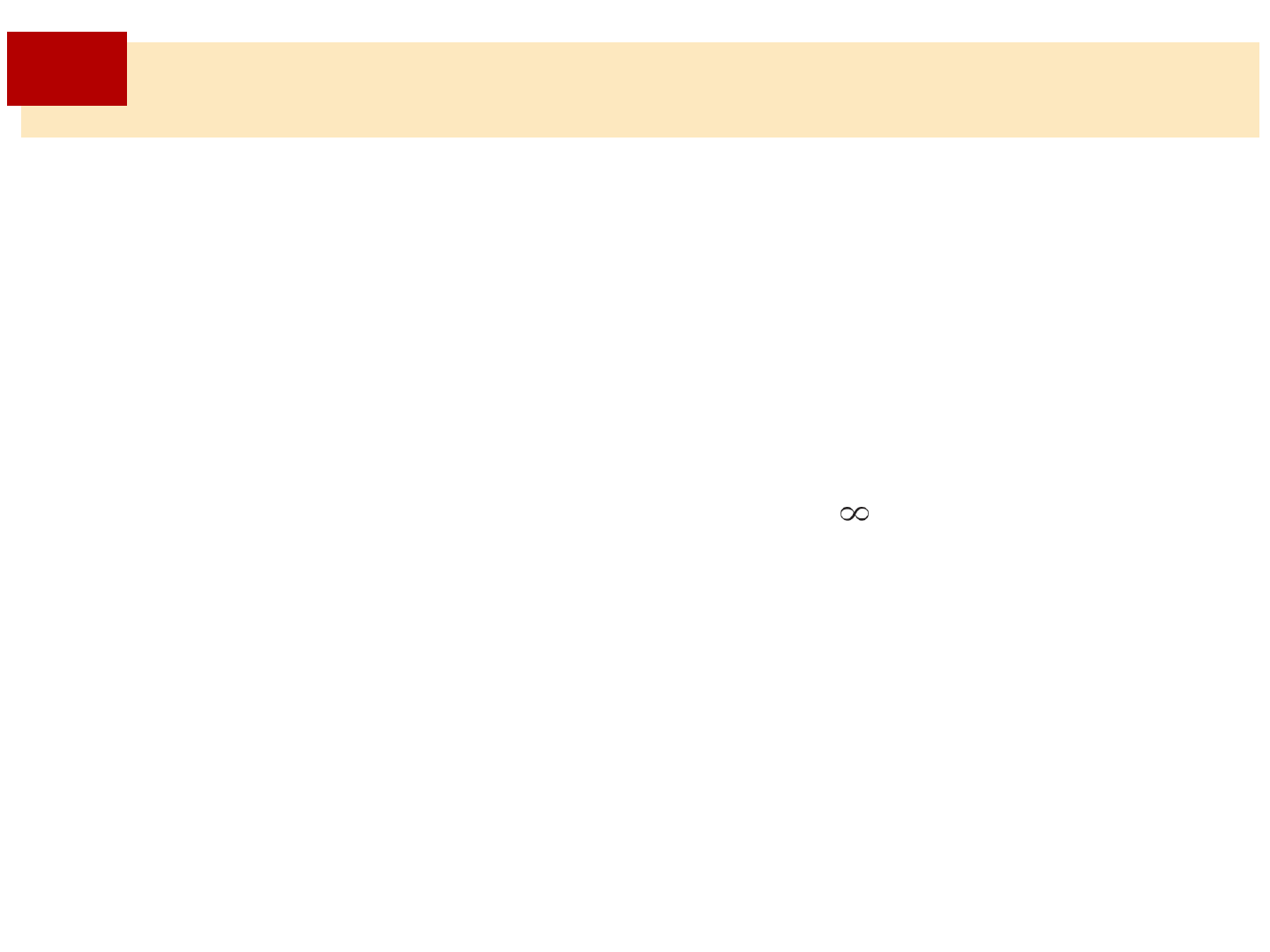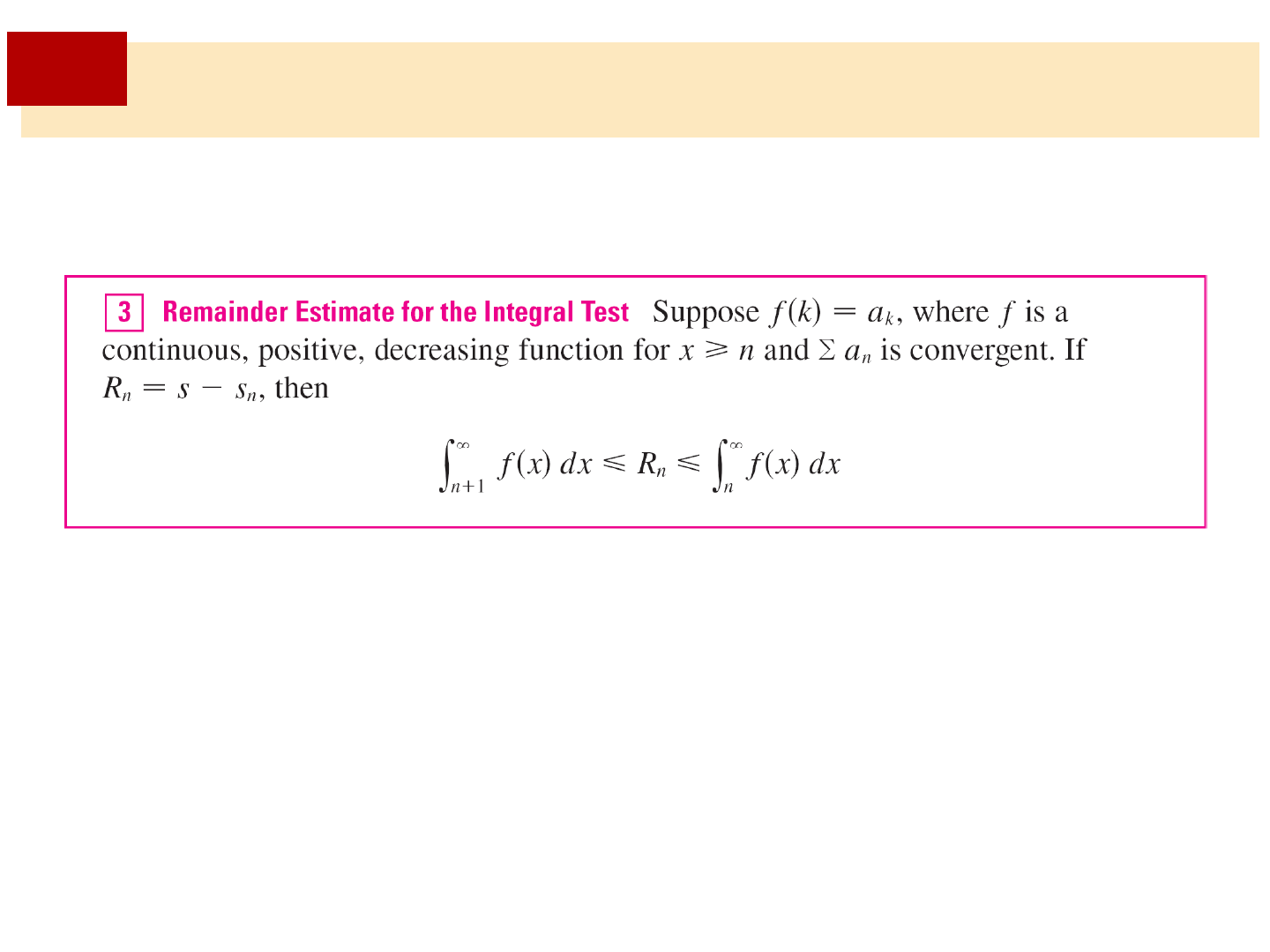
Infinite Sequences and Series
8

The Integral and Comparison Tests; Estimating Sums
8.3

3
The Integral and Comparison Tests; Estimating Sums
In general, it is difficult to find the exact sum of a series. We
were able to accomplish this for geometric series and the
series 1/[n(n + 1)] because in each of those cases we
could find a simple formula for the nth partial sum s
n
.
But usually it isn’t easy to compute lim
n→
s
n
.
Therefore in this section we develop tests that enable us to
determine whether a series is convergent or divergent
without explicitly finding its sum.

4
Testing with an Integral

5
Testing with an Integral
Let’s investigate the series whose terms are the reciprocals
of the squares of the positive integers:
There’s no simple formula for
the sum s
n
of the first n terms,
but the computer-generated
table of values given to the right
suggests that the partial sums
are approaching a number
near 1.64 as n → and so it
looks as if the series is convergent.

6
Testing with an Integral
We can confirm this impression with a geometric argument.
Figure 1 shows the curve y = 1/x
2
and rectangles that lie
below the curve.
The base of each rectangle is an interval of length 1; the
height is equal to the value of the function y = 1/x
2
at the
right endpoint of the interval.
Figure 1

7
Testing with an Integral
So the sum of the areas of the rectangles is
If we exclude the first rectangle, the total area of the
remaining rectangles is smaller than the area under the
curve y = 1/x
2
for x 1, which is the value of the
integral
The improper integral is convergent and has value 1. So the
picture shows that all the partial sums are less than

8
Testing with an Integral
Thus the partial sums are bounded and the series
converges. The sum of the series (the limit of the partial
sums) is also less than 2:
Now let’s look at the series

9
Testing with an Integral
The table of values of s
n
suggests that the partial sums
aren’t approaching a finite number, so we suspect that the
given series may be divergent.

10
Testing with an Integral
Again we use a picture for confirmation. Figure 2 shows the
curve but this time we use rectangles whose tops
lie above the curve.
The base of each rectangle is an interval of length 1. The
height is equal to the value of the function at the
left endpoint of the interval.
Figure 2

11
Testing with an Integral
So the sum of the areas of all the rectangles is
This total area is greater than the area under the curve
for x 1, which is equal to the integral
But we know that this improper integral is divergent. So the
sum of the series must be infinite, that is, the series is
divergent.

12
Testing with an Integral
The same sort of geometric reasoning that we used for
these two series can be used to prove the following test.

13
Example 1 – Using the Integral Test
Determine whether the series converges or
diverges.
Solution:
The function f(x) = (ln x)/x is positive and continuous for
x > 1 because the logarithm function is continuous.
But it is not obvious whether or not f is decreasing, so we
compute its derivative:

14
Example 1 – Solution
Thus f'(x) < 0 when ln x > 1, that is, x > e. It follows that f is
decreasing when x > e and so we can apply the Integral
Test:
Since this improper integral is divergent, the series (ln n)/n
is also divergent by the Integral Test.

15
Testing with an Integral
The series is called the p-series.
For instance, the series
is convergent because it is a p-series with p = 3 > 1. But the
series
is divergent because it is a p-series with

16
Testing by Comparing

17
Testing by Comparing
The series
reminds us of the series which is a geometric
series with a = and r = and is therefore convergent.
Because the series (2) is so similar to a convergent series,
we have the feeling that it too must be convergent. Indeed, it
is. The inequality
shows that our given series (2) has smaller terms than those
of the geometric series and therefore all its partial sums are
also smaller than 1 (the sum of the geometric series).

18
Testing by Comparing
This means that its partial sums form a bounded increasing
sequence, which is convergent.
It also follows that the sum of the series is less than the sum
of the geometric series:
Similar reasoning can be used to prove the following test,
which applies only to series whose terms are positive.

19
Testing by Comparing
The first part says that if we have a series whose terms are
smaller than those of a known convergent series, then our
series is also convergent.
The second part says that if we start with a series whose
terms are larger than those of a known divergent series,
then it too is divergent.

20
Testing by Comparing
Standard Series for Use with the Comparison Test
In using the Comparison Test we must, of course, have
some known series b
n
for the purpose of comparison.
Most of the time we use one of these series:
▪ A p-series [ 1/n
p
converges if p > 1 and diverges if p 1;
see (1)]
▪ A geometric series [ ar
n–1
converges if |r| < 1 and
diverges if |r| 1]

21
Example 3 – Using the Comparison Test
Determine whether the series converges
or diverges.
Solution:
For large n the dominant term in the denominator is 2n
2
, so
we compare the given series with the series 5/(2n
2
).
Observe that
because the left side has a bigger denominator. (In the
notation of the Comparison Test, a
n
is the left side and b
n
is
the right side.)

22
Example 3 – Solution
We know that
is convergent because it’s a constant times a p-series with
p = 2 > 1.
Therefore
is convergent by part (a) of the Comparison Test.
cont’d

23
Testing by Comparing
Consider the series
The inequality
is useless as far as the Comparison Test is concerned
because b
n
= is convergent and a
n
> b
n
.
Nonetheless, we have the feeling that 1/(2
n
– 1) ought to
be convergent because it is very similar to the convergent
geometric series .

24
Testing by Comparing
In such cases the following test can be used.

25
Estimating the Sum of a Series

26
Estimating the Sum of a Series
Suppose we have been able to use the Integral Test to show
that a series a
n
is convergent and we now want to find an
approximation to the sum s of the series.
Of course, any partial sum s
n
is an approximation to s
because lim
n→
s
n
= s. But how good is such an
approximation? To find out, we need to estimate the size of
the remainder
R
n
= s – s
n
= a
n+1
+ a
n+2
+ a
n+3
+
The remainder R
n
is the error made when s
n
, the sum of the
first n terms, is used as an approximation to the total sum.

27
Estimating the Sum of a Series
We use the same notation and ideas as in the Integral Test,
assuming that f is decreasing on [n, ). Comparing the
areas of the rectangles with the area under y = f(x) for x > n
in Figure 3, we see that
Similarly, we see from Figure 4 that
Figure 3
Figure 4

28
Estimating the Sum of a Series
So we have proved the following error estimate.

29
Example 6 – Estimating the Sum of a Series
(a) Approximate the sum of the series 1/n
3
by using the
sum of the first 10 terms. Estimate the error involved in
this approximation.
(b) How many terms are required to ensure that the sum is
accurate to within 0.0005?
Solution:
In both parts (a) and (b) we need to know With
f(x) = 1/x
3
, which satisfies the conditions of the Integral Test,
we have

30
Example 6 – Solution
(a) Approximating the sum of the series by the 10th partial
sum, we have
According to the remainder estimate in (3), we have
So the size of the error is at most 0.005.
cont’d

31
Example 6 – Solution
(b) Accuracy to within 0.0005 means that we have to find a
value of n such that R
n
0.0005. Since
we want
Solving this inequality, we get
We need 32 terms to ensure accuracy to within 0.0005.
cont’d

32
Estimating the Sum of a Series
If we add s
n
to each side of the inequalities in (3), we get
because s
n
+ R
n
= s. The inequalities in (4) give a lower
bound and an upper bound for s.
They provide a more accurate approximation to the sum of
the series than the partial sum s
n
does.
